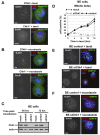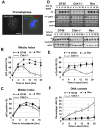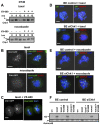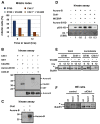Chk1 is required for spindle checkpoint function
- PMID: 17276342
- PMCID: PMC7115955
- DOI: 10.1016/j.devcel.2007.01.003
Chk1 is required for spindle checkpoint function
Abstract
The spindle checkpoint delays anaphase onset in cells with mitotic spindle defects. Here, we show that Chk1, a component of the DNA damage and replication checkpoints, protects vertebrate cells against spontaneous chromosome missegregation and is required to sustain anaphase delay when spindle function is disrupted by taxol, but not when microtubules are completely depolymerized by nocodazole. Spindle checkpoint failure in Chk1-deficient cells correlates with decreased Aurora-B kinase activity and impaired phosphorylation and kinetochore localization of BubR1. Furthermore, Chk1 phosphorylates Aurora-B and enhances its catalytic activity in vitro. We propose that Chk1 augments spindle checkpoint signaling and is required for optimal regulation of Aurora-B and BubR1 when kinetochores produce a weakened signal. In addition, Chk1-deficient cells exhibit increased resistance to taxol. These results suggest a mechanism through which Chk1 could protect against tumorigenesis through its role in spindle checkpoint signaling.
Figures







Comment in
-
Chk1: a double agent in cell cycle checkpoints.Dev Cell. 2007 Feb;12(2):167-8. doi: 10.1016/j.devcel.2007.01.005. Dev Cell. 2007. PMID: 17276330
Similar articles
-
Chk1: a double agent in cell cycle checkpoints.Dev Cell. 2007 Feb;12(2):167-8. doi: 10.1016/j.devcel.2007.01.005. Dev Cell. 2007. PMID: 17276330
-
The small molecule Hesperadin reveals a role for Aurora B in correcting kinetochore-microtubule attachment and in maintaining the spindle assembly checkpoint.J Cell Biol. 2003 Apr 28;161(2):281-94. doi: 10.1083/jcb.200208092. Epub 2003 Apr 21. J Cell Biol. 2003. PMID: 12707311 Free PMC article.
-
Aurora B couples chromosome alignment with anaphase by targeting BubR1, Mad2, and Cenp-E to kinetochores.J Cell Biol. 2003 Apr 28;161(2):267-80. doi: 10.1083/jcb.200208091. J Cell Biol. 2003. PMID: 12719470 Free PMC article.
-
Exercising restraints: role of Chk1 in regulating the onset and progression of unperturbed mitosis in vertebrate cells.Cell Cycle. 2007 Apr 1;6(7):810-3. doi: 10.4161/cc.6.7.4048. Epub 2007 Apr 22. Cell Cycle. 2007. PMID: 17377502 Review.
-
The right place at the right time: Aurora B kinase localization to centromeres and kinetochores.Essays Biochem. 2020 Sep 4;64(2):299-311. doi: 10.1042/EBC20190081. Essays Biochem. 2020. PMID: 32406506 Free PMC article. Review.
Cited by
-
Checkpoint kinase 1 in DNA damage response and cell cycle regulation.Cell Mol Life Sci. 2013 Nov;70(21):4009-21. doi: 10.1007/s00018-013-1307-3. Epub 2013 Mar 19. Cell Mol Life Sci. 2013. PMID: 23508805 Free PMC article. Review.
-
An Inhibitor of PIDDosome Formation.Mol Cell. 2015 Jun 4;58(5):767-79. doi: 10.1016/j.molcel.2015.03.034. Epub 2015 Apr 30. Mol Cell. 2015. PMID: 25936804 Free PMC article.
-
Discovery of benzo[e]pyridoindolones as kinase inhibitors that disrupt mitosis exit while erasing AMPK-Thr172 phosphorylation on the spindle.Oncotarget. 2015 Sep 8;6(26):22152-66. doi: 10.18632/oncotarget.4158. Oncotarget. 2015. PMID: 26247630 Free PMC article.
-
Direct regulation of Chk1 protein stability by E3 ubiquitin ligase HUWE1.FEBS J. 2020 May;287(10):1985-1999. doi: 10.1111/febs.15132. Epub 2019 Nov 29. FEBS J. 2020. PMID: 31713291 Free PMC article.
-
Genetic screen in Drosophila melanogaster uncovers a novel set of genes required for embryonic epithelial repair.Genetics. 2010 Jan;184(1):129-40. doi: 10.1534/genetics.109.110288. Epub 2009 Nov 2. Genetics. 2010. PMID: 19884309 Free PMC article.
References
-
- Carvalho A, Carmena M, Sambade C, Earnshaw WC, Wheatley SP. Survivin is required for stable checkpoint activation in taxol-treated HeLa cells. J Cell Sci. 2003;116:2987–2998. - PubMed
-
- Cheeseman IM, Anderson S, Jwa M, Green EM, Kang J, Yates JR, 3rd, Chan CS, Drubin DG, Barnes G. Phospho-regulation of kinetochore-microtubule attachments by the Aurora kinase Ipl1p. Cell. 2002;111:163–172. - PubMed
Publication types
MeSH terms
Substances
Grants and funding
LinkOut - more resources
Full Text Sources
Other Literature Sources
Molecular Biology Databases
Miscellaneous

